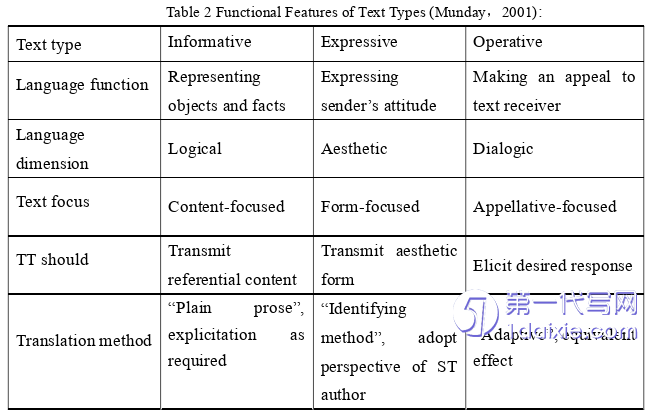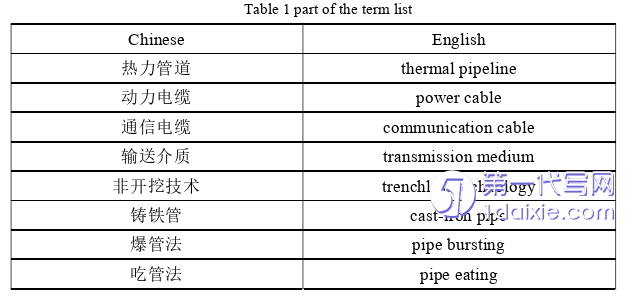本文是一篇英语论文,笔者发现赖斯的文本类型理论实用性较好,能够指导管道原位更新技术文本的翻译,在一定程度上拓展了该理论的应用领域,也希望笔者的努力能为这种文本类型的翻译提供一些有益的借鉴和启发。
1.Description of the Translation Report
1.1 Background of the Translation Task

The translation material selected by the author comes from the third chapter of Application of Trenchless Technology in Underground Pipelines——pipeline in-place replacement technology. The reason explaining the author’s choice of a book on trenchless technology as the material is related to the author’s internship experience. From July 2021 to January 2022, the author has been working as an intern in a local enterprise in Liuzhou. It is an enterprise mainly engaged in the production and sales of various types of horizontal directional drilling rigs. During the internship, the author has completed many translation tasks including the C-E translation of several drilling rig operation manuals and both C-E and E-C subtitle translations of various popular science videos on trenchless technology. This internship experience enables the author not only to have a good understanding of the principle of trenchless technology and its advantages over traditional open-cut pipeline renewal methods, but also to have accumulated some practical translation experience in this field. Besides, against the backdrop that the “Belt and Road” initiative endeavors to advance the global infrastructure construction, translating books on trenchless technology into English will also enable more technology-underdeveloped areas, including South America and Africa, to understand and then have access to this technology featuring high efficiency, so as to promote the high-quality development of global infrastructure projects. For these reasons above, the chapter “pipeline in-place replacement technology” was chosen as the source text (ST).
1.2 Significance of the Translation Task
In recent years, the transformation and upgrading of the manufacturing industry and technological innovation has been strongly advocated and supported. And trenchless technology, as cutting-edge technology with thriving vitality and continuous development, is undoubtedly in line with the national policy orientation. Over the years, it has played an increasingly significant role in the fields of tunnel excavation, pipeline laying, pipeline repair and replacement. However, to the author’s knowledge, far from enough translation work involved in the trenchless field has been done at present. Many companies, including the company where the author worked as an intern, do far from standardized translation of this technology. Therefore, the author chose a chapter on trenchless technology as the translation material, which will help to further standardize the translation in this field to a certain extent and promote high-tech exchanges between different countries.
In addition, the selected material features strict logic, accurate language, and rich information, which are in accordance with the characteristics of information texts. Therefore, the author classifies the material into information texts. When doing the translation work, the author, under the guidance of Reiss’s text type theory, strives to ensure the coherence and accuracy of the translation through translation skills such as conversion, addition, and sentence restructuring, so as to faithfully convey the content of the source text and make a summary on this basis. It can be said that the combination of theory and practice has a certain positive effect in advancing the popularization of text type theory, and further enriches the case study of the application of the theory to scientific and technological texts.
2. Description of the Translation Process
2.1 Before Translation
2.1.1 Analysis of the Source Text
Translators are first the readers of the source text (ST) and then the authors of the target text (Li, 2012). Being proficient in both English and Chinese is far more than enough for a translator to achieve high-quality translation. Only by thoroughly reading the source text and making a detailed analysis of it, can the translator ensure the quality of the subsequent translation, which is applicable for the translation of scientific and technological texts as well. As the name suggests, scientific and technological texts are texts that expound on natural science, and engineering and technological science. And they can be monographs, papers, scientific reports or popular scientific and technological books, etc. Typically, they are characterized by rich information and high-standard professionalism. If the translator wants to translate these texts, great efforts should be made, which means a thorough analysis of them can not be enough that additional reserve of a certain amount of professional technology is definitely needed for translators who generally are not familiar with the field of science and technology. Without the relevant professional knowledge, the translation made by the translator is very likely to be inaccurate or unprofessional (Gu, 2017).
To better finish the translation task, the author did a lot of pre-translation work. First, full knowledge of the syntactic structure and text style of the selected material is required for the translator. Based on the linguistic features and text type of the source text, the author decided to take Reiss’s text type theory as the theoretical framework to guide the subsequent translation practice. Furthermore, the pre-translation work involves queries and reserves of background knowledge. Although the author had a certain understanding of trenchless technology and accumulated some experience with it during the previous internship, most of the previous translation was about the trenchless horizontal directional drilling rig and its construction technology. The author still didn’t know much about the principle of trenchless technology. Besides, there are obvious differences between pipe bursting and conventional trenchless technology in many aspects, which requires the author to further explore and inquire.
2.2 While Translation
2.2.1 Comprehension and Expression
The two general processes of translation are to comprehend the ST first and then express the meanings of the TT (Shi, 2012). In the chapter on pipeline in-place replacement technology, pipe bursting is introduced thoroughly from different dimensions, with an aim to enable more people to know the technology and have a relatively systematic understanding of it. At the lexical level, the source text, as a typical scientific and technological text, covers plentiful professional terms, such as “玻璃黏土” (glass clay), “球墨铸铁” (nodular cast iron), “锥形爆管头” (cone-shaped bursting head) , etc., which need to be attentively queried for their accurate translation by the translator. Besides, it is also necessary for the translator to understand the meanings of these terms. At the syntactic level, there are vast numbers of long sentences and compound sentences in the source text, which are of considerable difficulty to translate. To smoothly complete the translation of these sentences, the translator needs to figure out the structure and inherent logic of them. And at the textual level, the source text shares the consistent characteristic of Chinese text, that is the emphasis on Parataxis or implicit cohesion, while the English text is just the opposite with the emphasis on Hypotaxis or explicit cohesion. Thus, the translator, during the process of translation, should hold the differences in Chinese and English expressions with regard.

3. Reiss’s Text Type Theory.......................................10
3.1 A Brief Review of Text Type Theory..................................10
3.2 Feasibility in Guiding Translation of Source Text.................................11
4. Case Study..........................................13
4.1 Lexical Level............................................13
4.1.1 Transforming Verbs into Nouns..................................13
4.1.2 Transforming Verbs into “Be + Prepositional phrases”...................15
5. Conclusion.................................................27
5.1 Major Findings........................................27
5.2 Limitations and Suggestions.............................27
4. Case Study
4.1 Lexical Level
As is known to all, various differences exist in language expression among different nationalities. Each language has its own inherent characteristics and unique ways of expression. For example, Chinese sentences tend to be dynamic, while English sentences are usually static. The reason why Chinese features dynamic nature is that the verb in Chinese has no morphological change. It can act as a variety of components in Chinese sentences, including predicate, attribute, object, and so on. As with English, it, in formal style, often expresses actions and behaviors by using nouns or noun phrases and the predicate in English is generally feeble or light verbs. Therefore, English is characterized by static nature (Sa, Feng, 2012). Translators should be aware of this difference between English and Chinese and adopt appropriate translation methods in response.
There are plentiful verbs and verb phrases in the translation materials. In order to meet the expression habits of the target language, the author transformed the dynamic feature of the source language into the static feature of the target language. And the three main translation methods for them are as follows.
5. Conclusion
5.1 Major Findings
First of all, being proficient in both English and Chinese does not mean that he or she is competent for the translation of scientific and technological texts. To do a good job in translating these texts, translators are required to have a certain amount of background knowledge reserve, by which they can accurately understand the meaning of the source text and then reproduce the information in the target text. Otherwise, wrong understanding of the ST because of the lack of background knowledge will not only confuse the target language readers, but also cause other serious consequences, such as construction failure. Therefore, the translator, before the actual translation work, should consult relevant background materials as much as possible. In addition, the establishment of a term list for the unification of terms is also needed so as to facilitate the subsequent translation work.
Secondly, the translator should be aware of the differences between Chinese and English, whether at the lexical, syntactic or textual level. Besides, the features of EST should be understood as well. During the translation process, the requirements mentioned above need to be taken into consideration. And the translator is expected to make the TT conform to the expression of the target language, and convey the information of the ST to the greatest extent.
Finally, translation should be carried out under the guidance of appropriate translation theories. If the chosen theory is unsuited, translation methods and strategies adopted by the translator are very likely to be inappropriate, which will pose challenges to the reproducing of the function of the ST.
reference(omitted)
